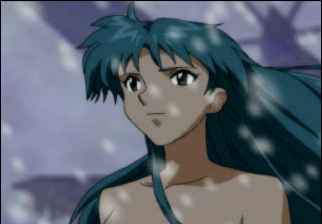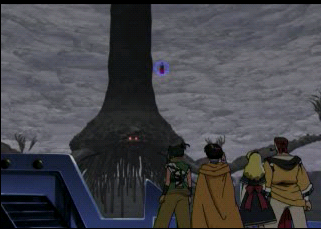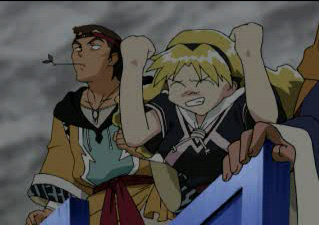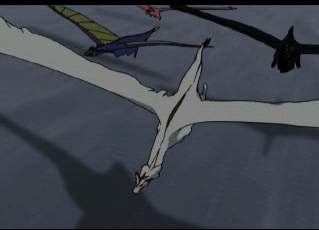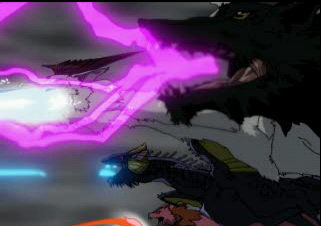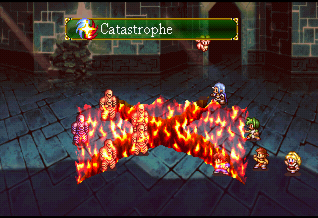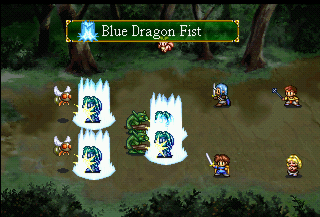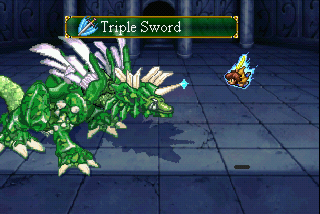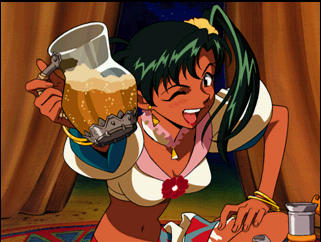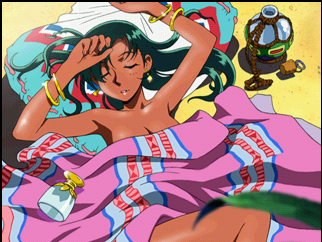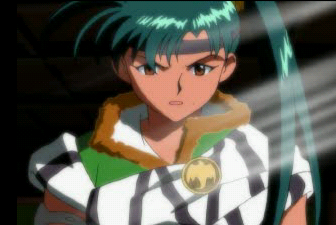Introduction
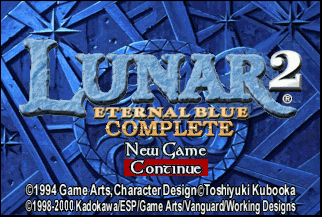
As previously mentioned, my introduction to the RPG genre, came in the PlayStation era, with the release of the highly anticipated Final Fantasy VIII. With that wonderful game acting as an entry point, I was propelled into a decade-long journey of exploring innumerable JRPGs. My first venture outside of Square’s vaunted Final Fantasy series was catalyzed by a recurring advertisement in GamePro magazine, a full page spread featuring gorgeous anime-style art of a picturesque azure-haired women and a young man adorned with green battle paint, defying his otherwise gentle gaze.
The game being so prominently featured was Lunar 2: Eternal Blue Complete for the PlayStation. I remember wanting the game for almost a year and repeatedly staring at the ad in an effort to satisfy my appetite for the what seemed to be an incredibly unique experience in a polygon dominated 32-bit era.
Needless to say, this only made matters worse. Knowing almost nothing about the game, my imagination ran wild; my young mind creating a number of possible stories behind the characters. I spent months perseverating on the image, with hopes that I would eventually add the game to my collection.
Then of course came the day. Having just finished my Cheesy Gordita Crunch, a rare treat, from the mall food court’s Taco Bell, I finally convinced my mom to buy the most extravagantly packaged game we had ever seen. The box was seemingly ten times larger than a conventional PlayStation game, my young mind certainly exaggerated its grandiosity, and it was made of cardboard rather than the standard plastic.
The nuance of the packaging was only outweighed by the contents: a hardbound instruction manual that included a walkthrough for the games opening, a reversible map/poster, stand-up cardboard characters, and a large gold-plated medallion that matched the necklace worn by the game’s apparent heroine.
The instruction manual helped me endure the remainder of my mother’s shopping trip while I was nearly trembling with anticipation. When I finally made it home to my room and popped in the disk, I was treated to something truly astounding.
Visuals: 8.5/10
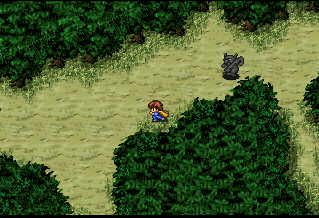
At the time of its release Lunar 2: Eternal Blue Complete received solid scores in nearly all categories, with the exception of one: graphics.
This was perhaps a bit unfair; at the time, the burgeoning 3rd dimension of gaming had finally reached the point of being the expected standard, and 2D games were often scoffed at as “old” by more casual fans and even critics.
What was undeniable though, is that Lunar 2’s anime cutscenes stood shoulders above much of what was available at the time, and are possibly some of the best on the PSX/Saturn. These cutscenes look amazing even today and provide a smoother presentation and greater resolution than the SEGA CD version. Cutscenes are also extended and more detailed providing improved visual story telling than was possible on the older console peripheral.
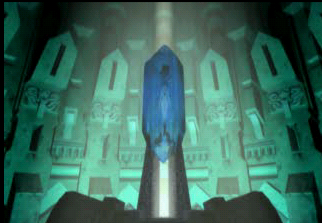
As I sat watching the opening I was stunned by the quality of the illustration, the stark, barren environment of the Blue Star, and incorporation of 3D elements into the animation, but mostly by the fact that I had just seen my first naked cartoon-chick, in Lucia.
These gorgeous cutscenes also contain complete English voice over work, something that was a rarity at the time, often sent by the wayside in exchange for more technically demanding 3D visuals in cutscenes, like the silent film approach taken by Final Fantasy series.
Though most certainly not the first game with voice overs, it was the first I had played with actual dialogue sequences being voiced, and I was absolutely stunned.
Aside from mere preferential treatment towards polygons due to novelty, there is some merit to the criticisms of Lunar 2’s 2D visuals.
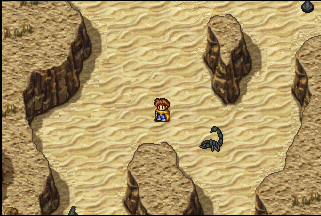
For example, despite having incredible art design overall, the graphics are only a moderate improvement from the SEGA CD version. The character sprites are colorful, but tiny, giving the appearance of a Super Nintendo RPG, rather than a next generation interpretation of 2D graphics. It is sad to think what could have been in this regard when thinking of the graphical 2D standouts that occasionally made an appearance on the PSX, with highlights like Legend of Mana, the Breath of Fire series, Mega Man 8 and the Mega Man X series.
In-battle enemy sprites are an improvement, being absolutely gorgeous and incredibly detailed, which helps compensate for the puny party members. This is somewhat negated by the enemy sprites outside of battle, which are mere monochromatic representations of those that grace the battle screen.
The games venues are a bit of a mixed bag as well; piercing spires adorned with intricately detailed glyphs, haunted mountain-top mansions and gorgeous partially submerged ruins are counterbalanced with generic, bland JRPG forests and caves that make one question whether they are playing the same game. Luckily, the former significantly outnumber the disappointing latter in regards to the game’s settings making these minor blemishes easy to overlook.
Overall, the graphics are not perfect, but offer enough highlights to outweigh the shortcomings.
Sound: 8/10
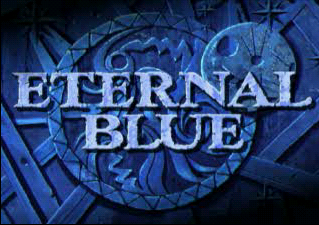
LUNAR 2’s visual presentation is accompanied by an impressive and varied soundtrack, which conveniently enough is packaged with the game as an additional disk. The disk contains the tracks from the LUNAR 2 with better audio quality than the actual in-game music. Though this is definite bonus points, I will be judging the PlayStation version of the songs, considering I am rating the game, not an album.
“Eternal Blue,” the track gracing the game’s introductory sequence, and its accompanying narration, provides historical context and lore to set the stage for LUNAR 2’s story. The music simultaneously elucidates past events, while still leaving enough ambiguity to evoke a sense of mystery in the listener.
Opening with a flute-like synth, “Eternal Blue” is almost haunting and incredibly memorable. This is easily one of my favorite songs in the series.
Another top-notch composition is “Gypsy Heart (Jean’s Theme).” With a fun and jazzy feel, it seems to highlight Jean’s fun-loving exterior that acts to mask her darker past.
Some other standouts include “Lucia’s Song,” “Ghaleon’s theme“, and “Blue Star,” which help define their respective characters, settings and times in history.
Having a strong soundtrack is critical in a JRPG, helping motivate the player through some of the portions of the genre that feel like work. As I have said before, nothing is more critical to a JRPG with regards to sound than providing an absolutely stellar collection of battle themes. “Brave Warriors” and “Boss Battle” are the game’s battle and boss themes, respectively. Both are well done and catchy, but lack a certain umph required to elevate them to greatness. While not bland, the are a little less intense than I would like and are a disappointment considering the incredibly high-quality of some of the game’s other tracks.
These are just a few important tracks that have to be considered in the evaluation of the game’s musical presentation. The OST is above average and provides a wide array of different sounds that are really capable of stirring up the emotions intended by the game’s creators, but ultimately suffers from average quality MIDI sounds, merely average battle themea and the changing or removal of a few awesome tracks that were in the SEGA CD version.
Aside from the music the game has some pretty solid English voice acting, especially considering the crappy quality we were used to back in the 90s. At times it can be a little goofy, but the quirkiness provides an added level of charm that helps the characters endear themselves to the player.
Despite being well done, I daresay the voice acting may have been a step down from the SEGA CD version, with a few characters voices being much better in the original incarnation. While a bit perturbing, these changes in voice acting are definitely not something that would sway me from playing the updated version.
One major weakness of the game’s audio presentation is its lackluster sound effects. Though crappy sound effects make me laugh, this charm may be lost on most people. It honestly sounds like there was no attempt to upgrade the sound effects from the SEGA CD version, and they simply sounded dated even upon release.
Overall, though not perfect, LUNAR 2 provides enough of an aural delight to keep the player engaged and offers some notable tracks that can be considered some of the best in the genre.
Gameplay: 9/10
LUNAR 2: Eternal Blue Complete provides an absolutely stellar gameplay experience. With an epic narrative, possibly the best cast in JRPG history, a dynamic battle system that integrates movement and enemy distance, a slew of physical and magical techniques, and light character customization in the form of magic-imbued accessory items, LUNAR 2 is a step above its turn-based JRPG contemporaries, despite appearing simple upon first glance.
The game opens with Hiro, an amateur archaeologist, and his flying pet “cat” Ruby exploring a cave near their Grampa Gwyn’s house. After escaping near certain doom, they decide to head back home.
On the way, they come across an overzealous knight exclaiming a “destroyer” will be descending upon the Blue Spire and they should hurry home.
Hiro’s curiosity eventually leads him to the Blue Spire where he and Ruby meet with the so-called destroyer, a timid young woman who claims she was sent to save the world from a great evil called Zophar.
This chance encounter leads to the trio embarking on a journey filled with danger, romance, misguided antagonists, and lecherous ex-priests, resulting in one of the most colorful narratives in the JRPG genre.
As mentioned this narrative is complemented by one of my favorite JRPG casts off all time.
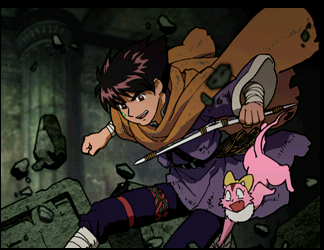
Hiro is a dynamic, though somewhat stereotypical, protagonist. A young explorer whose lust for adventurer ultimately sets him on a path not so different from his idol, Dragonmaster Alex.
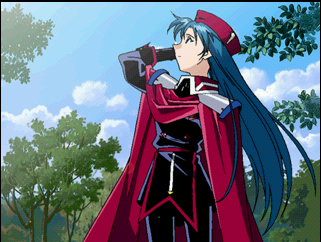
Lucia is the off-world beauty that serves the Goddess Althena. At first, she is overcome with her sense of duty to defeat Zophar, but as time goes on her love for humanity overshadows even her mission.
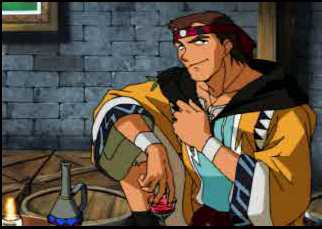
Ronfar is the vagabond ex-priest, whose life of piety was interrupted by tragedy. At the time of joining the party he spends most of his time womanizing, shooting dice, and getting wasted. He offers much of the game’s comic relief, especially thanks to the hilarious Working Designs localization.
Jean is a gypsy dancer with a mysterious, haunting past. Her prowess on the dance floor is overshadowed only by her ruthlessness in combat. While she knows how to have fun, she has an unparalleled focus in trying times.
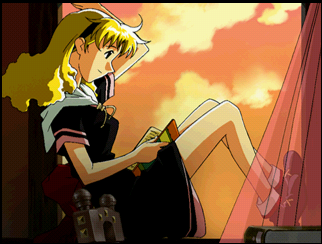
Lemina is the Junior Premier of the once glorious Vane Magic Guild. Her goal of returning the guild to its former status via forceful membership acquisition and hording cash, leads to her crossing paths with the party and ultimately joining them.

Leo, the psuedo-antagonist whose blind loyalty to his cause acts as a detriment to his otherwise benevolent and morally-sound personality. Another incredibly dynamic character that the player watches change immensely over the course of the game.
This memorable main cast is supplemented by a colorful cast of quirky antagonists, allies and neutral NPCs. The dialogue of even the most insignificant NPC is well written and often hilarious, making exploration of every corner of the LUNAR 2 worthwhile.
What would a great cast and storyline be without equally great gameplay mechanics?
As mentioned LUNAR 2‘s turn-based system is differentiated from the pack by addition of movement, formation and distance affecting attacks. This system makes character placement important and allows the player to stash the more frail characters in the back.
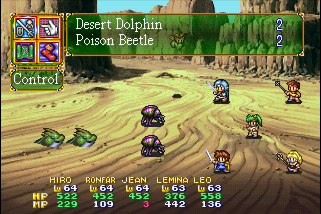
Movement is not the traditional switch from back row to front row, but rather it allows complete freedom to place the character anywhere in their movement range. This can also be arranged before battle allowing placement anywhere on the allied half of the battlefield. I feel the implementation of the movement mechanic in this updated version, is inferior to that of the SEGA CD version, for reasons that will be discussed in a future article, but it is still certainly a massive improvement over the norm of simply switching rows.
LUNAR 2 also has some well ahead-of-its-time quality of life improvements including no random encounters, unlike the SEGA CD version, a dash feature, and importantly an AI and pre-set strategy options that allow the player to have certain commands be performed at the start of battle and be repeated. These work together to really ease the grind and helps ward off the burn out often associated with constant battles.
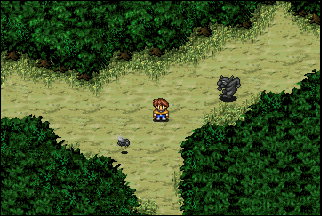
With regards to encounters, enemies are visible while traversing dungeons, and no battles occur on the world map. While this is may seem marginally helpful at first, it is not optimally implemented. Unlike games like Chrono Trigger, in which the enemies are reasonably avoidable, LUNAR 2’s enemies are incredibly quick and often hard to avoid even while using the dash. This can result in making it pretty hard to avoid battles anyway, but can be a godsend when your party’s health is critically low. Another disadvantage is that, while avoidable, the grind is absolutely necessary in LUNAR 2. It is an old-school JRPG after all, so spending some time leveling is just par for the course.
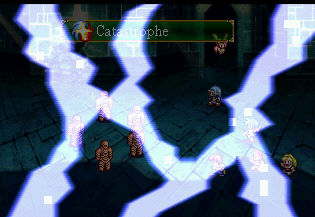
Thankfully, battles are fun and aside from the movement and AI features, have a strong turn-based backbone with a variety of visually exciting skills and magic that often needs to be carefully chosen to exploit enemy weaknesses. This especially applies to boss battles in which identifying weakness is nearly essential for success, unless the player is severely over-leveled.
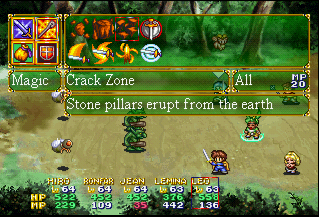
When the enemy is weak to magic, elemental weaknesses can be exploited by using spells of specific characters. Despite being physical attackers, Hiro and Leo use Wind and Earth magic respectively, while Lemina, the party’s general purpose mage, utilizes Fire, Ice, and Thunder magic.
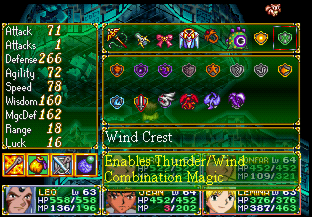
Despite these spells being initially locked to these specific characters, all characters can access magic by equipping certain accessories called crests, a new edition from the SEGA CD version. These crests offer access to a specific element, and equipping two permit dual-elemental magic, a rarity in most RPGs for sure.
There are also a variety of other crests that boost a certain stats, and even some that imbue the party with the ability to use dragon magic, a devastating, but costly set of spells.
Using crests to take advantage of weaknesses is not the only aspect of strategy to consider; is it worth spending valuable turns buffing the party with special techniques or going all out attacking from the gate? Often the buffs are worth it, but implementing them requires surviving the oppositions onslaught or utilizing other party members to keep the enemies or boss at bay.
Strategy is also crucial in even regular enemy encounters. Enemies begin in formations and make the player make key strategical choices. For example enemies that can attack from a distance may be behind melee opponents to force the party to break through the front line or use long-distance attacks of their own. These long-distance attacks generally consume MP, which must be replenished with fairly expensive items, something that must be considered when making these choices, especially early in the game when funds are sparse.
Another common scenario is a powerful enemy being surrounded by a large party of weaker enemies, this leads the player to having to make the choice of focusing on the powerful enemy or trying to quickly eliminate the associated henchmen. The correct choice is not always clear, and it often depends on the situation and the specific group of enemies present.
This is just a small sample of the surprisingly deep strategy present in the game’s battle system.
Aside from the awesome battle system, characters, story, and 90’s pop culture references, LUNAR 2 also provides an overall satisfying experience, especially after completing the game’s playable epilogue that not only ties up the story’s loose ends, but provides extra hours of gameplay and a challenging final dungeon. Despite some minor imperfections, LUNAR 2: Eternal Blue Complete is easily one of my favorite games of all time. I highly suggest it to anyone who enjoys classic JRPGs, be it in its Complete form on PSX or Saturn, or its equally excellent original form on SEGA CD.
LUNAR 2 Resources
LUNAR net: my primary source in staying up to date with all the latest news. In a time when LUNAR news is sparse, they still manage to stay vigilant and always are on top of the series. Also offers complete description of characters, artwork, interviews and so much more. The best LUNAR series resource I have come across.

